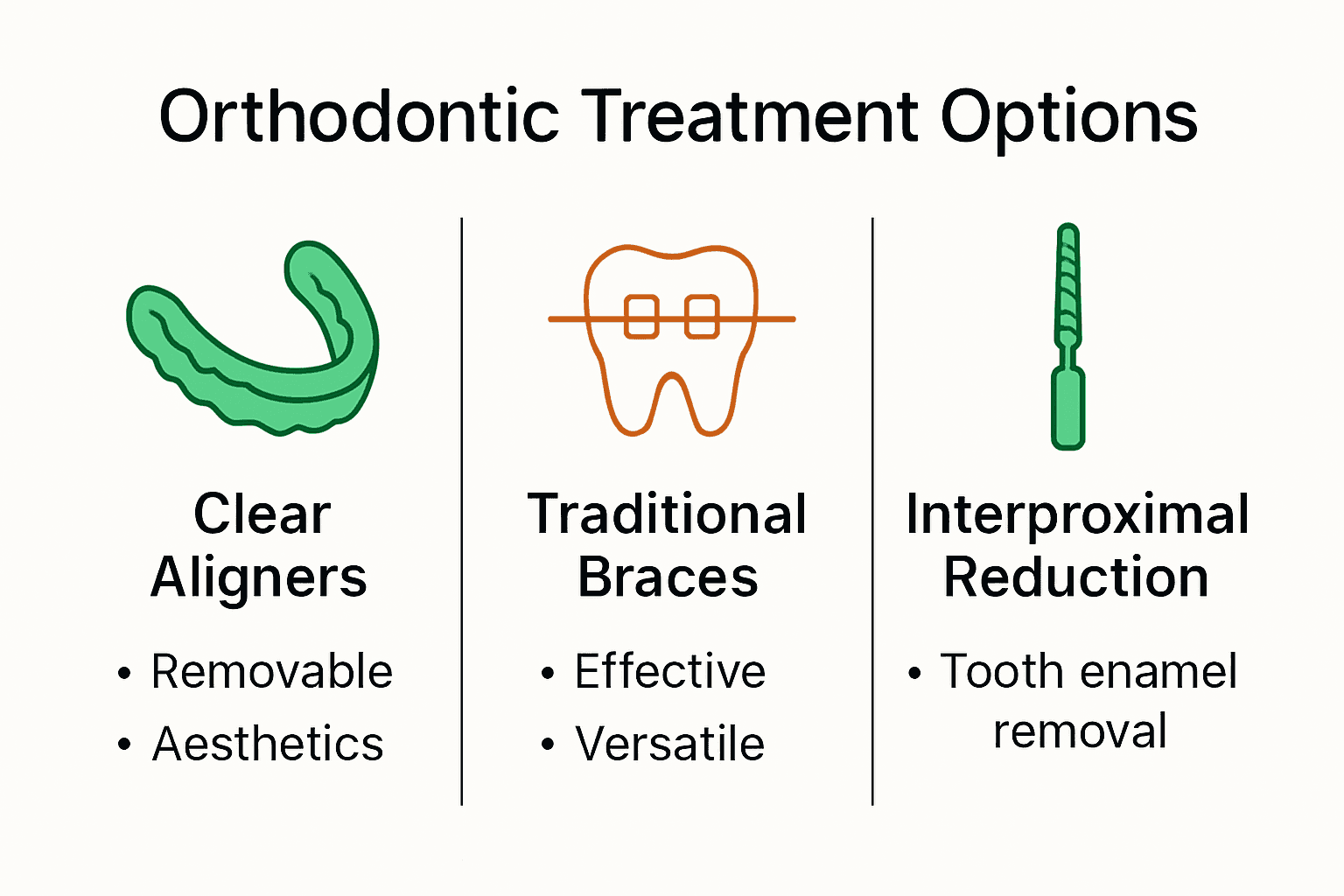Teeth Crowding Solutions: Step-by-Step Orthodontic Guide
October 15, 2025
Teeth Crowding Solutions: Step-by-Step Orthodontic Guide
Did you know that over 30 percent of adults struggle with teeth crowding at some point in their lives? Crooked or overlapping teeth can affect your confidence, make cleaning harder, and even impact your bite. Understanding how to address teeth crowding gives you a path to a healthier, straighter smile and helps you prevent bigger dental issues down the line. This guide shows practical steps to evaluate your alignment and choose the treatment that fits your unique needs.
Quick Summary
| Key Point | Explanation |
|---|---|
| 1. Schedule a dental examination | Start by booking a comprehensive dental exam with an orthodontist to assess crowding severity. |
| 2. Prepare for the consultation | Research orthodontic practices and bring your dental records and insurance information to streamline your first appointment. |
| 3. Evaluate treatment options | Discuss recommended treatments with your orthodontist based on your specific crowding needs and preferences. |
| 4. Maintain excellent oral hygiene | Ensure optimal oral health before starting treatment to prevent complications and ensure effective correction. |
| 5. Track your treatment progress | Attend regular check-ups and document changes to evaluate the effectiveness of your orthodontic intervention. |
Table of Contents
- Step 1: Assess Teeth Crowding Severity
- Step 2: Schedule a Personalized Orthodontic Consultation
- Step 3: Select the Most Suitable Treatment Option
- Step 4: Prepare for and Begin Orthodontic Treatment
- Step 5: Monitor Progress and Confirm Alignment Success
Step 1: Assess Teeth Crowding Severity
In this step, you’ll learn how to evaluate the severity of teeth crowding through professional assessment techniques that help determine whether orthodontic intervention is necessary. Understanding your teeth crowding helps you make informed decisions about potential treatments.
Begin by scheduling a comprehensive dental examination with an orthodontic professional. During this initial assessment, your orthodontist will perform a detailed visual inspection and use specialized measurement techniques. According to the Little’s Irregularity Index, dental professionals quantitatively measure mandibular anterior crowding by examining horizontal displacements between tooth contact points.
Your orthodontist will carefully map out your dental alignment and calculate a specific score that classifies your crowding into categories: minimal, moderate, severe, or very severe. This systematic approach ensures an objective evaluation of your dental structure.
Pro Tip: Take clear photographs of your teeth from multiple angles before your appointment. These can help your orthodontist track changes and provide a baseline for future comparisons.

Additionally, your dental professional might employ the Tanaka and Johnston analysis, which estimates space availability for permanent teeth during mixed dentition. This technique calculates expected widths of unerupted canines and premolars relative to your dental arch capacity.
By the end of this assessment, you’ll have a comprehensive understanding of your teeth crowding severity and be prepared to discuss potential treatment options with your orthodontist. The next step involves reviewing specific recommendations tailored to your unique dental profile.
Step 2: Schedule a Personalized Orthodontic Consultation
In this step, you will set up your first comprehensive orthodontic consultation that will help determine the best treatment pathway for addressing your teeth crowding. Your initial appointment is a critical opportunity to gain professional insights into your dental health and potential orthodontic solutions.
Start by researching local orthodontic practices that specialize in your specific dental needs. When calling to schedule, request a new patient consultation specifically focused on teeth crowding assessment. Most practices offer convenient online booking or phone scheduling options.
According to Smile Office research, your initial consultation will involve a comprehensive clinical examination. This typically includes detailed assessments of your bite, facial structure, and precise tooth positioning. Your orthodontist will conduct thorough imaging studies to develop an accurate treatment plan.
Pro Tip: Bring your dental insurance information and any previous dental records to your first appointment to streamline the consultation process.
Research from Smile IE indicates that the consultation stage involves multiple diagnostic steps. Expect a visual assessment of your dental alignment, followed by specialized X-rays and potentially digital scans that map your exact dental positions. These diagnostic tools help determine whether braces, aligners, or alternative treatments will work best for your specific situation.
By the conclusion of this consultation, you will have a clear understanding of your orthodontic needs and potential treatment recommendations. The next step involves reviewing the detailed treatment options presented by your orthodontic professional.
Step 3: Select the Most Suitable Treatment Option
In this step, you will carefully evaluate and choose the most appropriate orthodontic treatment that matches your specific dental crowding needs and personal preferences. Understanding your options empowers you to make an informed decision about your oral health journey.
Carefully review the treatment recommendations provided by your orthodontist during the initial consultation. Different levels of teeth crowding require unique approaches. According to Shared Dental Care research, patients with mild to moderate crowding often benefit from clear aligners like Invisalign, which offer a discreet and removable solution.
For those with more complex dental alignment challenges, traditional braces might provide more comprehensive correction. Your orthodontist will help you understand the pros and cons of each treatment method based on your specific dental structure and crowding severity.
Pro Tip: Consider your lifestyle and comfort level when selecting a treatment. Clear aligners work best for patients committed to wearing them consistently and maintaining proper oral hygiene.
In some instances, Wikipedia research on Interproximal Reduction suggests alternative techniques like mechanically slimming enamel between teeth to gain space. This method can be an effective alternative to tooth extractions for correcting mild to moderate crowding.
Factors to consider include treatment duration, cost, aesthetic preferences, and your orthodontist’s professional recommendation. Some patients prioritize invisibility, while others focus on the most efficient correction method.
By the end of this process, you will have selected a personalized treatment plan that addresses your teeth crowding effectively.
The next step involves preparing for your chosen orthodontic treatment and understanding the implementation process.
Here’s a summary comparing common orthodontic treatment options for teeth crowding:

| Treatment Option | Best For | Key Advantages | Considerations |
|---|---|---|---|
| Clear Aligners | Mild Moderate Crowding |
Nearly invisible Removable |
Requires discipline May not suit severe cases |
| Traditional Braces | Moderate Severe Crowding |
Most comprehensive Works for all cases |
Noticeable Diet restrictions |
| Interproximal Reduction | Mild Moderate Crowding |
Avoids extraction No appliances needed |
Limited space gained Not for severe crowding |
Step 4: Prepare for and Begin Orthodontic Treatment
In this step, you will transition from treatment planning to actual orthodontic intervention by preparing your mouth and lifestyle for the upcoming correction process. Your careful preparation will help ensure a smooth and successful treatment experience.
According to Cruz Orthodontics, the first critical step is establishing exceptional oral hygiene before your treatment begins. This means thoroughly cleaning your teeth and gums, and potentially scheduling a professional dental cleaning to create an optimal starting point for your orthodontic journey.
Research from Level Orthodontics indicates that your initial appointment will involve comprehensive 3D scanning and photography. These detailed images help your orthodontist design precise appliances tailored specifically to your dental structure.
Pro Tip: Stock up on soft foods like yogurt, smoothies, and mashed potatoes for the first few days after your appliances are fitted. This will help you manage initial discomfort and adjust to your new orthodontic equipment.
Prepare to modify your diet by avoiding hard, sticky, or sugary foods that could potentially damage your braces or aligners. Your orthodontist will provide specific guidelines about dietary restrictions and recommended eating practices during treatment.
During your placement appointment, you will receive detailed care instructions about maintaining your new orthodontic appliances. This includes learning proper cleaning techniques, understanding potential discomfort management, and recognizing signs that might require professional attention.
By the conclusion of this step, you will have officially begun your teeth crowding correction journey with a clear understanding of your treatment protocol. The next phase focuses on adapting to your new orthodontic appliances and maintaining consistent care.
Step 5: Monitor Progress and Confirm Alignment Success
In this step, you will actively track your orthodontic treatment progress and ensure your teeth are moving precisely as planned. This critical phase transforms your dental correction from a theoretical plan into a measurable, successful transformation.
According to Wikipedia research on intraoral scanners, modern orthodontic technology now enables incredibly precise 3D digital tracking of your dental alignment. These advanced scanners capture detailed models that allow your orthodontist to simulate and compare treatment outcomes with remarkable accuracy.
As outlined by Harris Dental Associates, you will attend regular adjustment appointments typically scheduled every 4 to 8 weeks. During these sessions, your orthodontist will assess tooth movement, potentially adjust wires or aligners, and make any necessary modifications to your treatment plan.
Pro Tip: Take periodic selfies of your smile to personally track your progress. These can be motivating and help you visualize the gradual changes happening in your dental alignment.
These routine check-ups are more than simple maintenance. They represent strategic opportunities to confirm your teeth are moving exactly as designed. Your orthodontist will use professional assessments and advanced imaging to verify that each tooth is shifting into its optimal position.
As your treatment nears completion, these appointments will transition toward final alignment confirmation and preparation for retention. Your orthodontist will discuss the potential need for retainers to maintain your newly achieved dental structure.
By the conclusion of this step, you will have a comprehensive understanding of your treatment progress and be approaching the exciting final stages of your orthodontic transformation. The next phase involves preparing for treatment completion and long-term dental maintenance.
Ready for a Personalized Approach to Your Crowded Teeth?
Struggling with teeth crowding can feel overwhelming, especially when you want to make the right choices for your smile and comfort. The step-by-step guide you just explored shows how an in-depth assessment and a well-matched treatment plan like Invisalign or traditional braces can transform your confidence and dental health. But the real solution starts with personal care that addresses your specific needs, pain points, and concerns, like discomfort, crowded bite, or uncertainty about treatment options. Glow Orthodontics in Langley is dedicated to guiding you each step of the way using proven techniques like those discussed in the article—from thorough orthodontic evaluations to custom aligner fittings.

You can experience tailored solutions and welcoming support right here at Glow Orthodontics. Want to see how our professional team puts your alignment success first? Visit our main site and book your consultation today. Secure your appointment now to start your journey toward a confident, healthy smile. The sooner you act, the sooner your transformation begins.
Frequently Asked Questions
How can I assess the severity of my teeth crowding?
To assess the severity of your teeth crowding, schedule a comprehensive dental examination with an orthodontist. They will use specific measurement techniques to classify your crowding into categories like minimal, moderate, or severe.
What should I expect during my first orthodontic consultation for teeth crowding?
During your first consultation, expect a thorough clinical examination that evaluates your bite, tooth positioning, and facial structure. Bring dental records and insurance information to make the process smoother and help the orthodontist create an accurate treatment plan.
How do I choose the right orthodontic treatment for my teeth crowding?
Review the treatment options provided by your orthodontist, such as clear aligners or traditional braces, considering factors like your lifestyle, dental structure, and crowding severity. Discuss each option with your orthodontist to make an informed decision based on your individual needs.
What preparations are necessary before starting orthodontic treatment?
Before starting orthodontic treatment, establish good oral hygiene by thoroughly cleaning your teeth and possibly scheduling a professional dental cleaning. Also, stock up on soft foods to ease the transition after your appliances are fitted.
How will I monitor the progress of my orthodontic treatment for crowding?
You can monitor your orthodontic treatment progress by attending regular adjustment appointments every 4 to 8 weeks. Keep track of changes by taking periodic selfies of your smile, allowing you to visualize your gradual transformation.
What happens at the end of my orthodontic treatment for teeth crowding?
At the end of your treatment, your orthodontist will confirm the final alignment of your teeth and discuss the potential need for retainers to maintain your new dental structure. Be prepared to follow care instructions for your retainers to ensure your results last long-term.